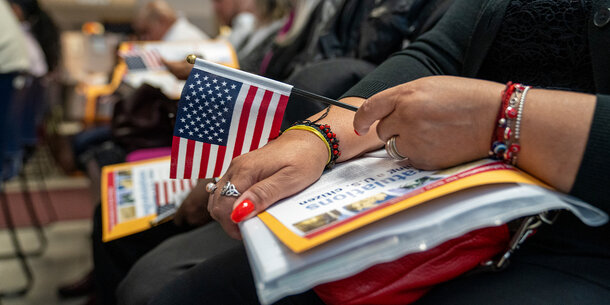Last summer, the Los Angeles Police Department (LAPD) became the latest police department to take violent action against peaceful protesters. Video footage shows LAPD officers acting less like protectors of the peace and more like an occupying force in a theater of war as they beat already subdued individuals with batons, shot noncombative people with so-called “less-than-lethal” munitions, and kettled protesters before arresting them en masse.
To those familiar with the history of policing in the United States, this behavior did not come entirely as a surprise. Some of the earliest iterations of policing are found in patrols and Night Watches that hunted down runaway slaves, both in the South and around the country. And law enforcement has a long and shameful history of cracking down on dissent, particularly when expressed by communities of color. Nonetheless, it would be a mistake to ignore the ways in which the more recent phenomenon of police militarization has played into the hostility that some police officers exhibit toward the communities they are intended to serve.
The material militarization of police has been on an upward trajectory since the presidency of Ronald Reagan, who “[allowed and encouraged] the military to grant civilian law enforcement agencies access to military bases, research, and equipment” as part of the “War on Drugs.” That anti-drug fervor continued into the 1990s, when Congress allowed the transfer of unused Department of Defense equipment to state and local law enforcement for counter-drug activities, a measure which was then replaced with what is now referred to as the “1033 Program,” named for its establishing numbered section in the 1997 National Defense Authorization Act.
Though these measures were intended strictly to mitigate drug trafficking, they resulted in an explosion of the use of military equipment for other purposes. We saw this militarization come to a head last summer, when riot police dressed for combat deployed flash grenades, used mine-resistant vehicles to drive through throngs of people, and surveilled activists from advanced spy planes, drones, and helicopters during the protests following the murder of George Floyd. It’s no wonder that calls to repeal the 1033 Program and demilitarize police have picked up steam in civil rights circles and in Congress.
But it’s not enough to see militarization as simply the use of military equipment. As Columbia University Law Professor Bernard Harcourt points out, along with tanks and night-vision goggles, American police in many cities have imported and adopted the mentality of the military, down to the idea that the residents of the communities where officers patrol are enemy combatants to be met with force. And it’s worth noting which populations are seen as those enemy combatants: left-wing protesters are much more likely to be subjects of police violence than right-wing protesters, who are often protected by police.
This development flies in the face of Americans’ longstanding belief that police and the military should be separate. It is an idea that can be traced back to the nation’s founding, when British soldiers quartered inside colonists’ homes ransacked rooms looking for evidence of treason against the Empire. The principle is also embodied in the Posse Comitatus Act, which prohibits the deployment of the federal armed forces to perform domestic law enforcement activities unless expressly authorized by Congress.
The military has a different role than the police. As a Minnesota National Guardsman told a reporter during the George Floyd protests, “We’re a combat unit not trained for riot control or safely handling civilians in this context. Soldiers up and down the ranks are scared about hurting someone, and leaders are worried about soldiers’ suffering liability.” Police, on the other hand, regularly come into contact with people whose civil rights they are required to respect and uphold. This difference in role should be reflected in a difference of capabilities.
Preventing an “us versus them” mentality is all the more important when police departments across the country have been infiltrated by white supremacists. While the overall percentage of white supremacists in law enforcement is likely low, incidents of white supremacy within police forces across the country for decades have eroded public trust in the police, and with good reason: the presence of white supremacist affiliations and views in police departments has been found to correlate with disproportionate policing of Black and brown communities as well as more use of force against those communities.
Many of the communities that police perceive as “them” are sorely in need of social services, not violent intervention. When police bring snipers to deal with mental health crises, for instance, they further damage an already tenuous relationship between their departments and their neighborhoods. As sociology professor and coordinator of the Policing and Social Justice Project at Brooklyn College Alex Vitale writes, “The alternative is not more money for police training programs, hardware or oversight. It is to dramatically shrink their function. We must demand that local politicians develop non-police solutions to the problems poor people face.”
So, yes, we should demilitarize the police because “when all you have is a hammer, everything looks like a nail.” We should ask police to make meaningful changes to how they interact with civilians instead of allowing them to use equipment built for war when engaging with the public. But we need to demilitarize the police because of militarization’s poisonous effect on policing culture. Today, the commonly understood duty of police — to “protect and serve” — is far too often replaced by a combative approach.
Ultimately, reforming police must include — but cannot be limited to — repealing the 1033 program and implementing stronger protections for subjects of police violence. Fixing police culture will require revising training that traumatizes recruits, rooting out white supremacy, and perhaps even reimagining policing altogether to shift many of the functions police perform to government entities better suited to do that work.



